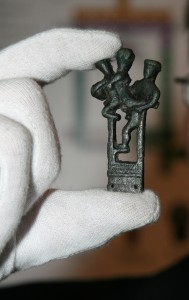 This is not a new find but it’s new to me and it’s too awesome not post about. In 2008, metal detectorist David Barker found a bronze Roman knife handle buried under a farmer’s field in Syston, Lincolnshire. It wasn’t a big money find, but what made it stand out was its erotic design. There’s a male on the right engaging in coitus with a woman facing him, her legs around his waist. A second male figure is behind her, his back to hers. In his arms he’s holding a decapitated head, clasping it to his chest.
This is not a new find but it’s new to me and it’s too awesome not post about. In 2008, metal detectorist David Barker found a bronze Roman knife handle buried under a farmer’s field in Syston, Lincolnshire. It wasn’t a big money find, but what made it stand out was its erotic design. There’s a male on the right engaging in coitus with a woman facing him, her legs around his waist. A second male figure is behind her, his back to hers. In his arms he’s holding a decapitated head, clasping it to his chest.
Erotic knife handles have been found before in Britain, but they’re rare. None of them also include a severed head, which makes this particular artifact unique, as far as we know.
Barker reported his find to the Portable Antiques Scheme and then sold it for just under £1,000 (ca $1,500) in December of that year to Lincoln museum The Collection which put it on display in its Roman gallery.
Collections officer at The Collection, Antony Lee, believes it is the cheekiest relic ever to be unearthed in Lincolnshire.
He said: “This has to be one of the county’s rudest finds. We have had some amazing finds in the past, but nothing quite this overt. The Romans certainly seemed to have no trouble expressing themselves. Other erotic knife handles have been found all over Britain, but ours is the only one with a decapitated head. It created quite a stir among staff and we’re expecting it to continue to draw lots of interest from the public.”
Mr Lee believes the knife dates from the 4th century and that it was fashioned for a specific and delicate task.
He said “We don’t yet know the full significance of the decapitated head, but we think it may not be as dark as it seems. For the Romans, decapitation was regarded with some reverence and respect.”
There are a lot of unanswered questions about this piece, on top of the mysterious role of the decapitated head in the ménage à trois. It might not even be a knife handle, for example, but the grip of some other tool.
Lincolnshire finds liaison officer Adam Daubney, to whom Barker first reported his discovery, thinks that it might be a symbolic design not meant to be read as a literal threesome with severed head. The imagery could have some religious significance for 4th century Britons, or it could be something as simple as a scene from the theater.